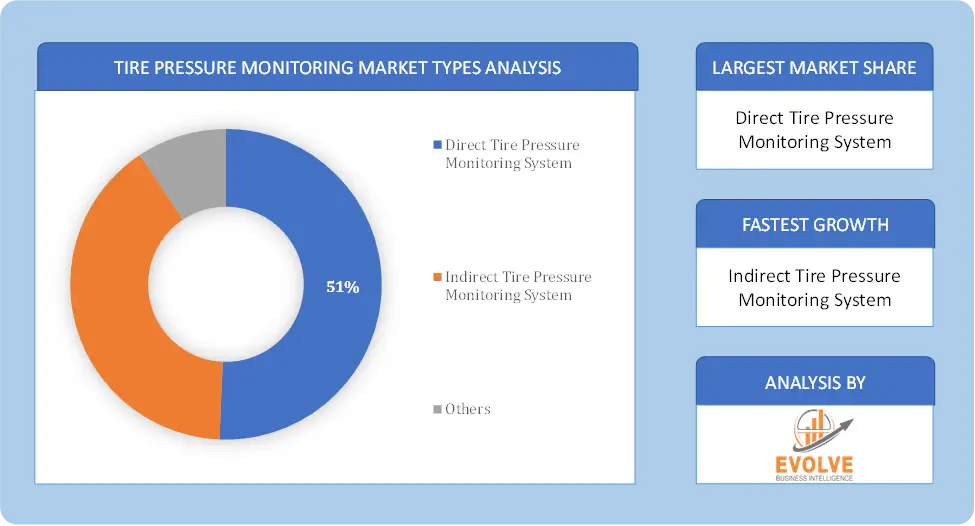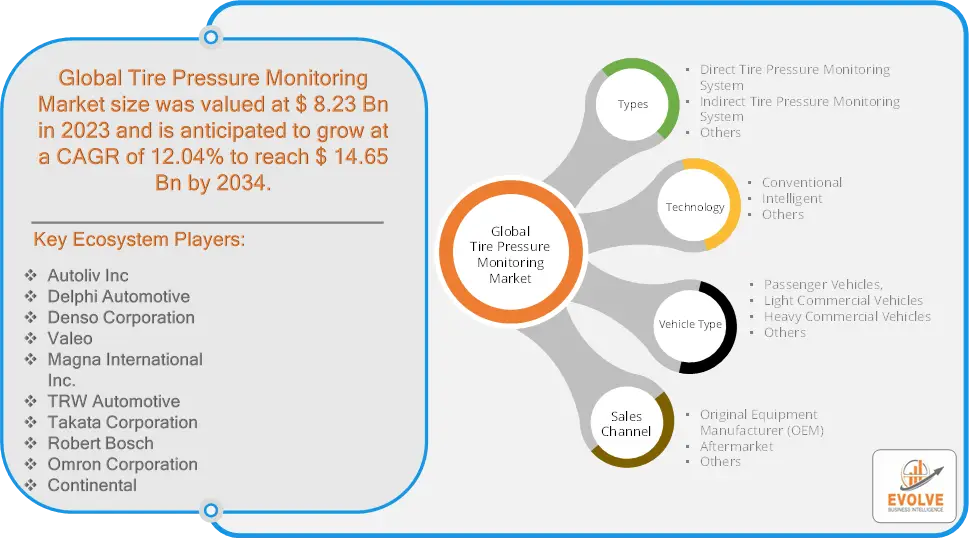Tire Pressure Monitoring Market Overview
The Tire Pressure Monitoring Market size accounted for USD 8.23 Billion in 2023 and is estimated to account for 8.99 Billion in 2024. The Market is expected to reach USD 14.65 Billion by 2034 growing at a compound annual growth rate (CAGR) of 12.04% from 2024 to 2034. The Tire Pressure Monitoring Market involves the development and sale of systems designed to monitor the air pressure in vehicle tires. These systems help ensure that tires are inflated to optimal levels, enhancing safety, fuel efficiency, and tire longevity.
The market is expected to grow as vehicle manufacturers continue to prioritize safety features and as regulatory standards evolve globally. The tire pressure monitoring market is expected to continue growing due to these factors and the increasing demand for advanced safety features in vehicles.
Global Tire Pressure Monitoring Market Synopsis
 Tire Pressure Monitoring Market Dynamics
Tire Pressure Monitoring Market Dynamics
The major factors that have impacted the growth of Tire Pressure Monitoring Market are as follows:
Drivers:
Ø Technological Advancements
Advancements in sensor technology, wireless communication, and the integration of TPMS with vehicle telematics and infotainment systems are driving market growth. Smart TPMS that offer real-time updates and predictive maintenance insights are gaining popularity. TPMS helps reduce the risk of accidents caused by under-inflated tires, which can lead to blowouts or reduced control. As consumer and manufacturer focus on road safety increases, the adoption of TPMS grows in response.
Restraint:
- Perception of High Costs of Advanced TPMS and Technological Complexity
The initial investment for direct TPMS, which includes sensors for each tire, can be high. This cost may deter some consumers, especially in price-sensitive markets. As TPMS become more integrated with vehicle systems, the complexity increases. Issues related to system compatibility, integration, and user understanding can pose challenges for both manufacturers and consumers.
Opportunity:
⮚ Integration with Smart Technologies
The integration of TPMS with smart technologies, such as IoT and vehicle-to-everything (V2X) communication, can enhance monitoring capabilities. This allows for real-time data sharing and alerts, improving overall vehicle safety and performance. With increasing awareness of environmental issues, TPMS can play a role in promoting fuel efficiency and reducing emissions. Marketing TPMS as a tool for sustainability could attract environmentally conscious consumers. Innovations in sensor technology, such as the development of more durable, accurate, and cost-effective sensors, can enhance the functionality of TPMS and drive market growth.
Tire Pressure Monitoring Market Segment Overview
By Types
 Based on Types, the market is segmented based on Direct Tire Pressure Monitoring System, Indirect Tire Pressure Monitoring System and Others. The direct TPMS segment dominant the market. Direct TPMS is dominating the market due to its favorable characteristics, such as high accuracy and reliability in providing real-time tire pressure data through sensors embedded in the tires. This level of precision is crucial in preventing road accidents, maintaining vehicle safety, extending tire life, and enhancing fuel efficiency.
Based on Types, the market is segmented based on Direct Tire Pressure Monitoring System, Indirect Tire Pressure Monitoring System and Others. The direct TPMS segment dominant the market. Direct TPMS is dominating the market due to its favorable characteristics, such as high accuracy and reliability in providing real-time tire pressure data through sensors embedded in the tires. This level of precision is crucial in preventing road accidents, maintaining vehicle safety, extending tire life, and enhancing fuel efficiency.
By Technology
Based on Technology, the market segment has been divided into Conventional, Intelligent and Others. The conventional TPMS segment dominant the market. Conventional TPMS is dominating the TMPS market due to its ability to directly measure air pressure and temperature. Placed inside each tire, the system uses battery-powered sensors to record and transmit real-time data to the vehicle’s onboard computer system using radio frequency (RF) technology. Such information is crucial for maintaining vehicle safety, extending tire life, and optimizing fuel efficiency.
By Vehicle Type
Based on Vehicle Type, the market segment has been divided into Passenger Vehicles, Light Commercial Vehicles, Heavy Commercial Vehicles and Others. The passenger vehicles segment dominant the market. due to stringent safety regulations that mandate the integration of the system in new passenger vehicles to improve road safety. Poorly maintained tires can be a cause of accidents, due to which automakers are increasingly installing the system into their vehicles. This is further supported by the increasing consumer consciousness about vehicle safety and the advantages of having real-time TPMS.
By Sales Channel
Based on Sales Channel, the market segment has been divided into Original Equipment Manufacturer (OEM), Aftermarket and Others. OEM is dominating the tire pressure monitoring system (TPMS) market due to various factors, such as stringent safety regulations that mandate the inclusion of the system in new vehicles. Manufacturers install TPMS directly during vehicle production and assembly to comply with such standards.
Global Tire Pressure Monitoring Market Regional Analysis
Based on region, the global Tire Pressure Monitoring Market has been divided into North America, Europe, Asia-Pacific, the Middle East & Africa, and Latin America. North America is projected to dominate the use of the Tire Pressure Monitoring Market followed by the Asia-Pacific and Europe regions.
Tire Pressure Monitoring North America Market
North America holds a dominant position in the Tire Pressure Monitoring Market. One of the largest markets due to strict regulatory requirements and high awareness of vehicle safety, advanced automotive technology, and significant adoption of electric and autonomous vehicles. Mature market with high penetration of TPMS in new vehicles and focus on advanced TPMS technologies and integration with other vehicle systems.
Tire Pressure Monitoring Asia-Pacific Market
The Asia-Pacific region has indeed emerged as the fastest-growing market for the Tire Pressure Monitoring Market industry. Rapidly growing due to the increasing automotive production and ownership in countries like China and India. Government mandates and rising consumer demand are driving the adoption of TPMS and expanding middle class, government initiatives to improve road safety, and rising awareness of tire maintenance.
Competitive Landscape
The global Tire Pressure Monitoring Market is highly competitive, with numerous players offering a wide range of software solutions. The competitive landscape is characterized by the presence of established companies, as well as emerging startups and niche players. To increase their market position and attract a wide consumer base, the businesses are employing various strategies, such as product launches, and strategic alliances.
Prominent Players:
- Autoliv Inc
- Delphi Automotive
- Denso Corporation
- Valeo
- Magna International Inc.
- TRW Automotive
- Takata Corporation
- Robert Bosch
- Omron Corporation
- Continental
Key Development
In May 2022, Continental launched CombineMaster and CombineMaster VF tires, a continuous TPMS that drives down overall operating costs by continuously monitoring the air pressure and temperature of the tires.
In September 2022, Chongqing Livan Automotive Technology Co., Ltd. (Livan Auto), a battery-swappable car brand supported by Geely Automobile and Lifan Technology, introduced two new models. These variants include a central console screen with an 8-inch LCD, a TPMS, and a HHC system.
Scope of the Report
Global Tire Pressure Monitoring Market, by Types
- Direct Tire Pressure Monitoring System
- Indirect Tire Pressure Monitoring System
- Others
Global Tire Pressure Monitoring Market, by Technology
- Conventional
- Intelligent
- Others
Global Tire Pressure Monitoring Market, by Vehicle Type
- Passenger Vehicles,
- Light Commercial Vehicles
- Heavy Commercial Vehicles
- Others
Global Tire Pressure Monitoring Market, by Sales Channel
- Original Equipment Manufacturer (OEM)
- Aftermarket
- Others
Global Tire Pressure Monitoring Market, by Region
- North America
- US
- Canada
- Mexico
- Europe
- UK
- Germany
- France
- Italy
- Spain
- Benelux
- Nordic
- Rest of Europe
- Asia Pacific
- China
- Japan
- South Korea
- Indonesia
- Austalia
- Malaysia
- India
- Rest of Asia Pacific
- South America
- Brazil
- Argentina
- Rest of South America
- Middle East & Africa
- Saudi Arabia
- UAE
- Egypt
- South Africa
- Rest of Middle East & Africa
| Parameters | Indicators |
|---|---|
| Market Size | 2033: $14.65 Billion |
| CAGR | 12.04% CAGR (2023-2033) |
| Base year | 2022 |
| Forecast Period | 2023-2033 |
| Historical Data | 2021 |
| Report Coverage | Revenue Forecast, Competitive Landscape, Growth Factors, and Trends |
| Key Segmentations | Types, Technology, Vehicle Type, Sales Channel |
| Geographies Covered | North America, Europe, Asia-Pacific, Latin America, Middle East, Africa |
| Key Vendors | Autoliv Inc, Delphi Automotive, Denso Corporation, Valeo, Magna International Inc., TRW Automotive, Takata Corporation, Robert Bosch, Omron Corporation and Continental. |
| Key Market Opportunities | • Integration with Smart Technologies • Rising Focus on Sustainability |
| Key Market Drivers | • Technological Advancements • Growing Focus on Vehicle Safety |
REPORT CONTENT BRIEF:
- High-level analysis of the current and future Tire Pressure Monitoring Market trends and opportunities
- Detailed analysis of current market drivers, restraining factors, and opportunities in the future
- Tire Pressure Monitoring Market historical market size for the year 2021, and forecast from 2023 to 2033
- Tire Pressure Monitoring Market share analysis at each product level
- Competitor analysis with detailed insight into its product segment, Government & Defense strength, and strategies adopted.
- Identifies key strategies adopted including product launches and developments, mergers and acquisitions, joint ventures, collaborations, and partnerships as well as funding taken and investment done, among others.
- To identify and understand the various factors involved in the global Tire Pressure Monitoring Market affected by the pandemic
- To provide a detailed insight into the major companies operating in the market. The profiling will include the Government & Defense health of the company’s past 2-3 years with segmental and regional revenue breakup, product offering, recent developments, SWOT analysis, and key strategies.







